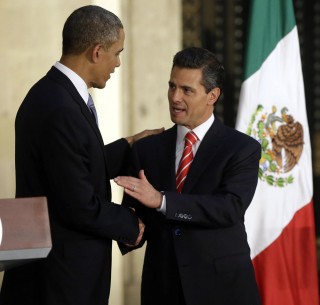
Hey guys, I’ve got a guest post today I think you’ll really enjoy by Jeffrey Nelson, who is a husband, father, author and bilingual living and working in the Midwestern United States. He lives with his Mexican wife and their son, Liam, who is currently being raised bilingual in English and Spanish. He runs the blog Living Bilingual. Check it out below:
One cultural issue that is ever-so-present in my world is the difference between Mexico and the United States as it relates to personal relationships. This is a cultural difference that is very apparent to members of each respective culture when interacting with people of the other culture. A few things I have noticed while experiencing this phenomenon are
the differences in personal space/physical contact, intensity with which people are greeted, and the expectations that exist when enter/exiting a situation.
The Personal Space Difference:
Mexicans greet each other in very different ways than Americans. In Mexico, women kiss everyone on the cheek when greeting them. A man, on the other hand, will kiss a woman on the cheek and shake the hand of another man. This hand shake usually involves a pat on the shoulder/bicep area or another hand placed on top of the hand being shaken.
The bottom line is that Mexicans are a lot more physical when greeting each other. Whether it’s a quick beso, a firm handshake that lingers, or all of the above plus a hug, they greet each other physically as opposed to the quick ‘hey’ that we Americans tend to throw out.
The Intensity of The Greeting:
Mexicans also greet each other with much more intensity than Americans. A big smile, the kiss, handshake, hug, combination depending on who is greeting whom, and a passionate como estas? Que bueno verte! [How are you? It’s so good to see you!]Mexicans greet each other like Americans would if they hadn’t seen each other in a few weeks/months as a standard greeting. My wife says good night to her parents every night in the same way I say good bye to my parents when we are headed back home from visiting them and won’t see them again for 3-6 months. A simple ‘hey, how are you doing?’ devoid of emotion is considered rude in Mexican culture. In America, we tend to tailor our greeting to the circumstance a lot more. For example, if I just saw you 10 minutes ago, and I will see you again in two hours, there may not even be a greeting.
In Mexico, the formal, excited, intense, drawn out greeting is there every.single.time. Whether I’m just going to the store for milk or am going off to war, it’s basically the same goodbye. This may be a slight exaggeration, however it isn’t as far-fetched as you might think if you don’t understand Mexican culture.
The Cultural Expectations When Greeting/Leaving Someone:
As I’ve stated, there are certain expectations that exist in Mexican culture when you are greeting and/or leaving a person or group of people. Basically, anytime you enter, re-enter, leave, return for your keys, whatever, you are expected to not only greet the people, but greet everyone individually with the kiss/hug/handshake/combo style. Even my wife will greet me formally every single time I come home from work, or from any other place. She will despedirse almost every morning while walking me to the door as I head out for work. This is just part of the culture. The hello/goodbye moments are very important to the Mexican people. It’s almost a sign of respect to acknowledge and greet individually everyone in the room at all times regardless of who they are or how comfortable you are with them; parents, spouses, children, etc.
Due to these three points, Mexicans often perceive Americans as cold, aloof, indifferent, and ultimately almost rude for the way we greet and interact with each other. To them, it’s ridiculous that we don’t hug and kiss our parents more, go on-and-on about how much we love them, or call them on the phone every day (or even once a week). The stereotype that family is incredibly important for Mexicans holds true, however it’s more of the way they express the importance.
While their language may be easier to learn than some, the true Mexican language consists of not only Spanish, but the way they use it to interact with each other. The true language of Mexico is a combination of Spanish and their diverse and special culture.
I learned to speak conversational Spanish in six months using TV shows, movies, and even comics: I then wrote a book on how you can, too
I have a whole method and a book I wrote about it called The Telenovela Method where I teach you how to learn Spanish from popular media like TV shows, movies, music, books, etc. that you can all find online for free. It was the #1 new release in the Spanish Language Instruction section on Amazon for nearly a month after it came out and currently has 17 reviews there with a 4.9/5 stars average. It's available for $7.99-$9.99 for the e-book version depending on who you buy it from (Kindle version on Amazon is now $7.99) and $16.99 for the paperback (occasionally a bit cheaper, again, depending on who you buy it from).
It's currently available in both e-book and paperback from:
Cheers,
Andrew







